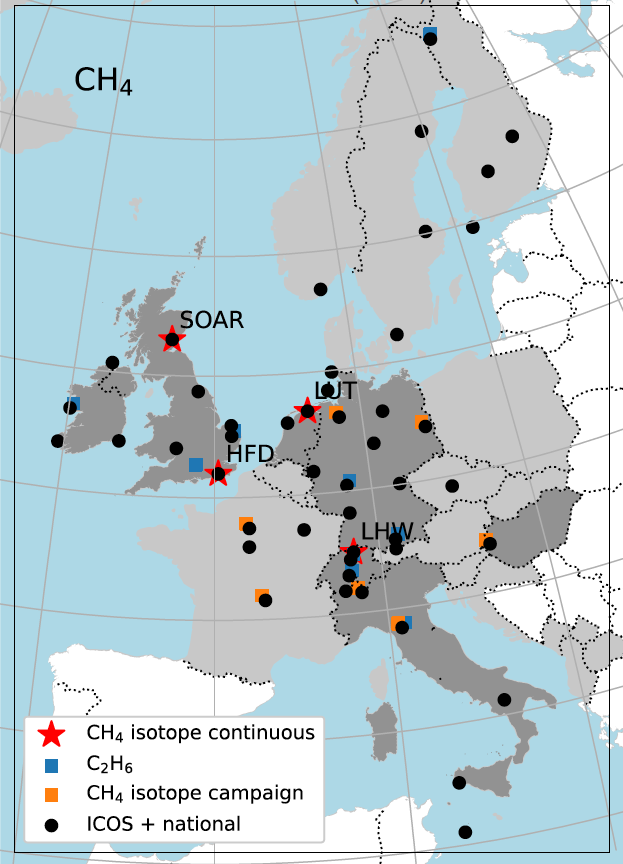Sector-level methane emission quantification
Objectives and ambitions
Increased methane (CH4) concentrations contribute about one-quarter of the radiative forcing due to warming agents in the atmosphere (Forster et al., 2021). Because of its importance to climate and its decadal lifetime in the atmosphere, many countries, including the those of the European Union and the United Kingdom are signatories to the Global Methane Pledge, which commits to reducing CH4 emissions by at least 30 % from 2020 levels by 2030. To track progress towards this goal, countries will quantify emissions through bottom-up methodologies supported, where possible, by top-down estimates. Europe’s CH4 emissions are primarily from the agricultural, waste and fossil fuel sectors and these sectors are targeted in the EU’s Methane Strategy. However, at present, it is challenging to attribute emissions derived from top-down studies to the individual sectors, limiting the benefit of top-down quantification to inventory compilers.
The most widespread method for attribution is to use the spatial partitioning from bottom-up models or inventories (e.g., Lunt, et al., 2021). An exciting alternative is to use atmospheric tracers that are co-emitted from certain sources, and the isotopic composition of CH4. Our previous work in Europe has largely employed this approach in “campaign-mode”, to investigate a particular source over a short time. This project, PARIS, will advance the co-emitted tracer (stable isotope ratios, ethane (C2H6)) approach for sectoral CH4 estimation by employing new continuous measurements in important regions where the source partitioning is not well-known. Advanced process attribution will be used to provide inventory compilers with better information about the sectors on which to focus efforts.
Methodology

PARIS focuses on the use of atmospheric observations of CH4 isotopic composition (δ13C and δD) and C2H6 – CH4 ratios (C2H6 is co-emitted from fossil sources) to derive sector-specific flux estimates. Measurements of the isotopic composition of CH4 have the potential to improve our understanding of CH4 emissions because different sources emit CH4 with source-specific stable isotope ratios. We aim to expand isotope monitoring capabilities across our focus countries. We will deploy two mobile instruments on a campaign basis to five new locations for 6–12 months to determine the optimal locations for long-term monitoring. In PARIS, we will begin a CH4 inverse modelling study by inferring total CH4 emissions for the whole of Europe using data from ICOS and national networks. We will then include isotope and ethane data in the inversion schemes to determine sector-level emissions for a subset of European countries. Sector-level and national total CH4 emission estimates will be compared to National Inventory Reports and incorporated into the WP2 inventory engagement process.
Tasks
Optimal measurement sites for new observations – Observation Simulation System Experiment (OSSE) will be conducted by modelling methane and the isotopic ratios to determine the most useful sites for high frequency methane isotope monitoring campaigns in Europe.
New methane isotope measurements – High-frequency measurements of δ13C-CH4 and δD-CH4 will be established at SOAR (UK) or Lutjewad (Netherlands), Heathfield (UK) and Zürich (Switzerland). Campaigns of 6-12 month duration using a mobile platform making high frequency, high precision isotope observations will be conducted at five additional sites between 2022 and 2024.
Source signatures characterisation around sites – Mobile surveys will be conducted in the vicinity of new measurement sites to characterise isotope source signatures.
Total methane emissions estimation – Total CH4 emissions estimates will be derived for Europe using various inverse modelling frameworks.
Sector-level methane emissions – The new CH4 δ13C and δD data from the task “New methane isotope measurements” and C2H6 measurements from AGAGE and ACTRIS will be integrated into inverse modelling systems used in the task “Total methane emissions estimation” to estimate methane emissions from the major source categories for the focus countries where enhanced observations will be available.
Comparison of top-down with UNFCCC reports – Top-down and reported CH4 emissions will be compiled for countries constrained by the observational network. In focus countries, estimates at sector-level will be compared annually in an Annex to the National Inventory Report. Discrepancies will be discussed considering best available error estimates for both bottom-up and top-down approaches.





